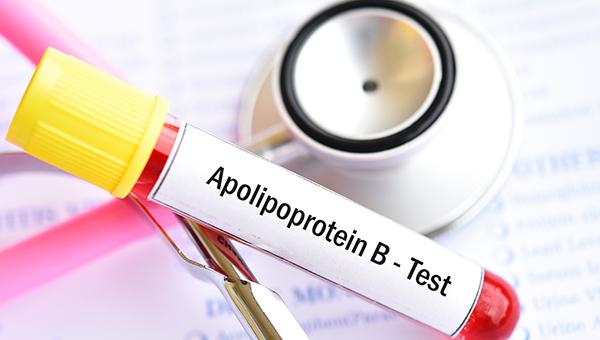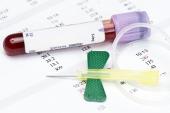ApoB Gains Ground as Best Lipid Predictor of MI Risk
Editorialists argue that apoB should be the default measure for assessing CVD risk, but others contend LDL still has a role.

The results, which showed that only apoB was associated with the risk of MI in a model that fully adjusted for other lipids and clinical factors, suggest that apoB “may be the primary driver of atherosclerosis” and that drug therapy should target all apoB-containing lipoproteins to reduce the risk of adverse cardiovascular events, say researchers.
“We looked at apolipoprotein B, non-HDL cholesterol, and triglycerides, and all three are predictive of risk when you look at them independently and without adjustment,” lead investigator Nicholas Marston, MD (Brigham and Women’s Hospital, Boston, MA), told TCTMD. “Even when you adjust for clinical factors, each were predictive of MI, which is the endpoint of interest in this study. However, when you also adjusted for the other lipid parameters, apolipoprotein B was the only one that remained significant.”
LDL cholesterol has long been the undisputed marker of cardiovascular risk and the key target for therapy, with statins, ezetimibe, or the PCSK9 inhibitors, but apoB has emerged as a strong marker of lipid burden and overall coronary heart disease risk, said Marston.
While LDL cholesterol, non-HDL cholesterol, and apoB concentrations are highly correlated, there are clinical scenarios where LDL cholesterol might underestimate the concentration of atherogenic apoB-containing lipoproteins, such as in patients with high triglyceride levels, diabetes, or obesity. Although the amount of cholesterol in these different lipoproteins—LDL, intermediate-density lipoprotein (IDL), very-low-density lipoprotein (vLDL), and triglyceride-rich lipoproteins—can vary, all have a single apoB particle, making it a reliable surrogate marker for the overall risk of cardiovascular disease related to atherogenic lipoproteins.
To TCTMD, Marston said there is now increasing focus on treating the residual risk associated with these other lipoproteins and the purpose of their new analysis was to identify the strongest predictor of MI in primary and secondary prevention patients. The question, he said, was whether the risk of MI was related to apoB, which is a measure of the total number of lipoproteins; to the “type” of particle (such as LDL, vLDL, or triglyceride-rich lipoproteins); or to the “content” of those particles (such as LDL cholesterol, non-HDL cholesterol, or triglycerides).
The results were presented last week at the American Heart Association 2021 Scientific Sessions and published simultaneously in JAMA Cardiology.
Higher Risks of MI With ApoB
The primary prevention cohort, a group not treated with lipid-lowering therapy, included 389,529 individuals (median age 56 years; 58% female) enrolled in the UK Biobank database. In a model adjusted for clinical risk factors alone, such as age, sex, body mass index, smoking status, hypertension, diabetes, race/ethnicity, and creatinine clearance, each 1-standard deviation (SD) increase in apoB, non-HDL cholesterol, and triglycerides was associated with a significant 38%, 36%, and 16% increase in the risk of MI. When lipid parameters were added to the fully adjusted model, only apoB remained significantly associated with a higher risk of MI (adjusted HR 1.27 per 1-SD increase; 95% CI 1.15-1.40).
For the secondary prevention patients, which included 40,430 patients randomized in the FOURIER and IMPROVE-IT trials, each 1-SD increase in apoB and non-HDL was associated with a 19% and 16% higher risk of MI, respectively. In the model adjusted for clinical risk factors plus apoB, non-HDL and HDL cholesterol, and triglycerides, only apoB was significantly associated with risk of MI (adjusted HR 1.17 per 1-SD increase; 95% 1.00-1.36).
In an editorial, Allan Sniderman, MD (McGill University Health Center, Montreal, Canada), Ann Marie Navar, MD, PhD (UT Southwestern Medical Center, Dallas), and George Thanassoulis, MD (McGill University Health Center), write that there’s been a lot of debate about whether apoB, LDL cholesterol, or non-HDL cholesterol should be the main measure of apoB lipoprotein-related risk. But that debate “is over,” they conclude. The new study, they say, provides definitive evidence that “apoB should be the primary marker to assess cardiovascular risk due to apoB lipoproteins.”
They point out that LDL and non-HDL cholesterol both become insignificant markers of risk when apoB is taken into account, “demonstrating that the risk of LDL cholesterol and non-HDL cholesterol is fully captured by the number—not the cholesterol content—of the apoB-containing particles.”
The editorialists note that apoB is less prone to measurement errors than LDL or non-HDL cholesterol and that past studies have shown apoB is a better predictor of who will benefit from lipid-lowering therapy. LDL cholesterol, state Sniderman, Navar, and Thanassoulis, is an “incomplete marker of the benefit of statin, ezetimibe, or PCSK9 therapy.”
The 2019 European Society of Cardiology/European Atherosclerosis Society guidelines for the management of dyslipidemias, recommend that physicians measure apoB for risk assessment, particularly in patients with high triglycerides, diabetes, obesity, metabolic syndrome, or very low LDL cholesterol levels. ApoB can also be used as alternative to LDL cholesterol as the primary means to screen, diagnose, and manage patients, according to the guidelines. ApoB is not currently endorsed by the US guidelines, but can be considered a “risk enhancer” if it exceeds 130 mg/dL.
Complement, Not Replace, LDL Cholesterol
Marston envisions a complementary role for apoB.
“Right now, [apoB] would be nice to have in combination with the lipid panel,” he said. “LDL cholesterol is very important, it’s what physicians are used to, and it’s what patients are used to. It’s also important to understand what’s driving the high apoB levels. I think we’d still very much want the lipid panel. Where it’s available, checking apolipoprotein B makes sense. Hopefully, more labs will begin to offer it because I think it would be a nice parameter to have along with LDL cholesterol and triglyceride levels, but I don’t think apolipoprotein B should replace LDL cholesterol by any means.”
Fatima Rodriguez, MD, MPH (Stanford University School of Medicine, CA), who wasn’t involved in the study, doesn’t actively measure apoB in her clinical practice, though her preventive cardiology group is in active discussions about changing that practice. “Barriers include lack of insurance coverage for apoB testing for many of our patients and our use of drugs that primarily target LDL cholesterol,” she said in an email.
However, like Marston and colleagues, she agrees that apoB is a better predictor of clinical events and “can be valuable in risk stratification beyond the regular lipid panel.”
From a research perspective, Marston noted that there has been a focus on therapies that lower triglycerides, or that lower LDL cholesterol and triglycerides. For clinical trials, investigators need to think about the best way to capture the effect of new drugs on both of these markers of cardiovascular disease risk. “ApoB ends up being the best measure of that, so for research studies, and clinical trials, having apoB as a key endpoint, along with these other parameters, would be important,” he said.
Michael O’Riordan is the Managing Editor for TCTMD. He completed his undergraduate degrees at Queen’s University in Kingston, ON, and…
Read Full BioSources
Marston NA, Giugliano RP, Melloni GEM, et al. Association of apolipoproteinB-containing lipoproteins and risk of myocardial infarction in individuals with and without atherosclerosis: distinguishing between particle concentration, type, and content. JAMA Cardiol. 2021;Epub ahead of print.
Sniderman AD, Navar AM, Thanassouilis G. ApolipoproteinB vs low-density lipoprotein cholesterol and non-high-density lipoprotein cholesterol as the primary measure of apolipoproteinB lipoprotein-related risk: the debate is over. JAMA Cardiol. 2021;Epub ahead of print.
Disclosures
- Marston reports no relevant conflicts of interest.
- Thanassoulis reporting serving on advisory boards/speaker bureaus for Amgen, Regeneron/Sanofi, HLS Therapeutics, Ionis, Servier, and Novartis and receiving grant funding from Servier and Ionis.
- Navar reports institutional research from Bristol Myers Squibb, Esperion, Amgen, and Janssen and honoraria and consulting fees from Amarin, Amgen, AstraZeneca, Boehringer Ingelheim, Bayer, CSL, Esperion, Janssen, Lilly, Sanofi, Regeneron, Novo Nordisk, Novartis, The Medicines Company, New Amsterdam, Cerner, 89bio, ZiZi, and Pfizer.





Comments